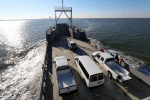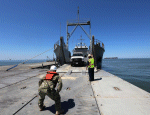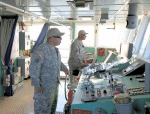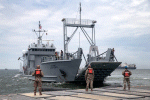NavSource Online: Army Ship Photo Archive
USAV Hobkirk (LCU-2023)
International Radio Call Sign:
Alpha - Delta - Mike - Uniform
ADMU
Please report any broken links or trouble you might come across to the Webmaster. Please take a moment to let us know so that we can correct any problems and make your visit as enjoyable and as informative as possible.
| Click On Image For Full Size Image | Size | Image Description | Source | |
|---|---|---|---|---|

302502301 |
85k | On April 25th, British Colonel Francis Rawdon marched out of Camden, just as Greene had hoped and began to march up the ridge. Rawdon's men marched up the ridge in a narrow formation, allowing Greene to attack from the front and both sides and gain an early advantage that inflicted heavy casualties on the British. Soon after the fight began, however, several of the key American leaders were shot, causing their units to break apart and flee. Rawdon took this advantage and charged up the hill, causing Greene to withdraw in full retreat, even though he had a much larger force. The Americans lost 270 killed, captured, wounded or missing, while the British lost 261. Photo - Revolutionary War and Beyond - Painting by Pamela Patrick White of the Battle of Hobkirk's Hill Map - The American Revolution in South Carolina - Sketch of the Battle of Hobkirk's hill by CAPT. Charles Vallancey of the Volunteers of Ireland |
Tommy Trampp | |

302502303 |
290k | USAV Hobkirk (LCU-2023), 7th Sustainment Brigade (Expeditionary), travels along the James River loaded with Joint Task Force Civil Support
vehicles during a Joint Logistics Over the Shore exercise 14 August 2014. JLOTS is the process of loading and unloading equipment and vehicles on vessels without the benefit of a fixed port
facility. JTF-CS anticipates, plans and prepares for CBRN defense support to civil authorities response operations.
US Navy photo # 140814-N-VJ282-995 NEWPORT NEWS August 14 2014, by U.S. Navy Petty Officer 1st Class Brian Dietrick. | Tommy Trampp | >|

302502304 |
239k | U.S. Army Sgt. Nathan Love, boatswain, USAV Hobkirk (LCU 2023), 7th Sustainment Brigade (Expeditionary), guides a Joint Task Force
Civil Support vehicle from the landing craft during a Joint Logistics Over the Shore exercise, 14 August 2014. JLOTS is the process of loading and unloading equipment and vehicles on vessels
without the benefit of a fixed port facility. JTF-CS anticipates, plans and prepares for CBRN defense support to civil authorities response operations
US Navy photo, by U.S. Navy Petty Officer 1st Class Brian Dietrick. | Tommy Trampp | >|

302502305 |
153k | U.S. Army Chief Warrant Officer 2 Arian Fernandez, vessel master, USAV Hobkirk (LCU-2023), 7th Sustainment Brigade (Expeditionary),
controls the helm of the landing craft during a Joint Logistics Over the Shore (JLOTS) exercise with Joint Task Force Civil Support, 14 August 2014. JLOTS is the process of loading and
unloading equipment and vehicles on vessels without the benefit of a fixed port facility. JTF-CS anticipates, plans and prepares for CBRN defense support to civil authorities response operations.
US Navy photo, by U.S. Navy Petty Officer 1st Class Brian Dietrick. | Tommy Trampp | >|

302502302 |
225k | U.S. Army Soldiers with 11th Transportation Battalion, 7th Transportation Regiment prepare for the docking of USAV Hobkirk (LCU-2023) on a
trident pier during exercise Resolute Sun at Fort Story, VA., 18 June 2019. U.S. Marines participated in the exercise to increase combat operational readiness in amphibious and prepositioning
operations while conducting joint training with the U.S. Army during a joint logistics over the shore scenario.
U.S. Marine Corps photo # 190618-M-QP496-1283 by Lance Cpl. Scott Jenkins. | Tommy Trampp | |

302502306 |
80k | Deactivated USAV Hobkirk (LCU-2023) and USAV Bristoe Station (LCU-2006) under tow by a an unidentified
US Army large tug, date and location unknown..
U.S. Army photo from The War Zone, July 12, 2021. |
Tommy Trampp | |
| Back To The Navsource Photo Archives Main Page | Back To The US Army Ship Index | Back To The US Army Landing Craft Utility Index |
| Comments, Suggestions, E-mail Webmaster. |
|
This page is created and maintained by Gary P. Priolo |